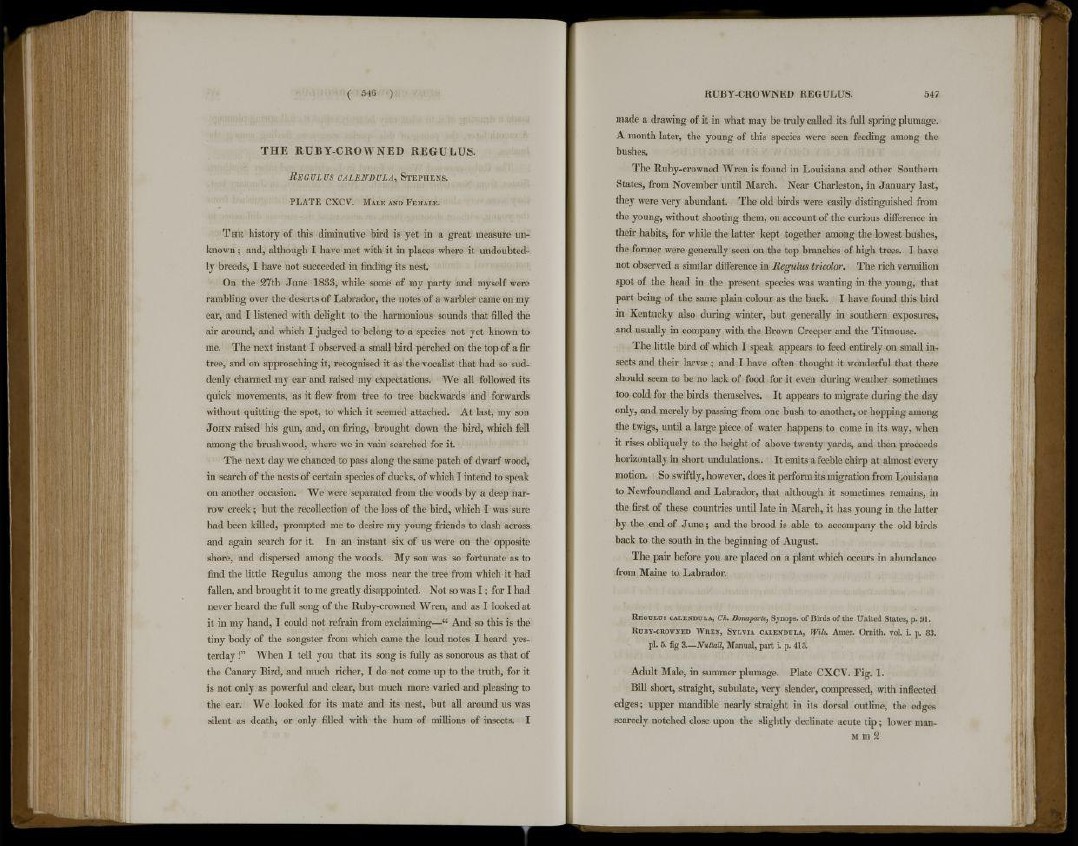
( 54« )
T H E R U B Y - C R O W N E D R E G U L U S .
REGULUS CALENDULA, STEPHENS.
P L A T E CXCV". MALE AND FEMALE.
THE history of this diminutive bird is yet in a great measure unknown
; and, although I have met with it in places where it undoubtedly
breeds, I have not succeeded in finding its nest.
On the 27th June 1833, while some of my party and myself were
rambling over the deserts of Labrador, the notes of a warbler came on my
ear, and I listened with delight to the harmonious sounds that rilled the
air around, and which I judged to belong to a species not yet known to
me. The next instant I observed a small bird perched on the top of a fir
tree, and on approaching it, recognised it as the vocalist that had so suddenly
charmed my ear and raised my expectations. We all followed its
quick movements, as it flew from tree to tree backwards and forwards
without quitting the spot, to which it seemed attached. At last, my son
JOHN raised his gun, and, on firing, brought down the bird, which fell
among the brushwood, where we in vain searched for it.
The next day we chanced to pass along the same patch of dwarf wood,
in search of the nests of certain species of ducks, of which I intend to speak
on another occasion. We were separated from the woods by a deep narrow
creek; but the recollection of the loss of the bird, which I was sure
had been killed, prompted me to desire my young friends to dash across
and again search for it. In an instant six of us were on the opposite
shore, and dispersed among the woods. My son was so fortunate as to
find the little Regulus among the moss near the tree from which it had
fallen, and brought it to me greatly disappointed. Not so was I ; for I had
never heard the full song of the Ruby-crowned Wren, and as I looked at
it in my hand, I could not refrain from exclaiming—" And so this is the
tiny body of the songster from which came the loud notes I heard yesterday
!" When I tell you that its song is fully as sonorous as that of
the Canary Bird, and much richer, I do not come up to the truth, for it
is not only as powerful and clear, but much more varied and pleasing to
the ear. We looked for its mate and its nest, but all around us was
silent as death, or only filled with the hum of millions of insects. I
RUBY-CROWNED REGULUS. 547
made a drawing of it in what may be truly called its full spring plumage.
A month later, the young of this species were seen feeding among the
bushes.
The Ruby-crowned Wren is found in Louisiana and other Southern
States, from November until March. Near Charleston, in January last,
they were very abundant. The old birds were easily distinguished from
the young, without shooting them, on account of the curious difference in
their habits, for while the latter kept together among the lowest bushes,
the former were generally seen on the top branches of high trees. I have
not observed a similar difference in Regulus tricolor. The rich vermilion
spot of the head in the present species was wanting in the young, that
part being of the same plain colour as the back. I have found this bird
in Kentucky also during winter, but generally in southern exposures,
and usually in company with the Brown Creeper and the Titmouse.
The little bird of which I speak appeal's to feed entirely on small insects
and their larvae ; and I have often thought it wonderful that there
should seem to be no lack of food for it even during weather sometimes
too cold for the birds themselves. It appears to migrate during the day
only, and merely by passing from one bush to another, or hopping among
the twigs, until a large piece of water happens to come in its way, when
it rises obliquely to the height of above twenty yards, and then proceeds
horizontally in short undulations.. It emits a feeble chirp at almost every
motion. So swiftly, however, does it perform its migration from Louisiana
to Newfoundland and Labrador, that although it sometimes remains, in
the first of these countries until late in March, it has young in the latter
by the end of June; and the brood is able to accompany the old birds
back to the south in the beginning of August.
The pair before you are placed on a plant which occurs in abundance
from Maine to Labrador.
REGULUS CALENDULA, Ch. Bonaparte, Synops. of Birds of the United States, p. 91.
RUBY-CROWNED WREN, SYLVIA CALENDULA, Wih. Amer. Ornith. vol. i. p. 8 3 .
pi. 5. fig 3.—Nuttall, Manual, part i. p. 415.
Adult Male, in summer plumage. Plate CXCV. Fig. 1.
Bill short, straight, subulate, very slender, compressed, with inflected
edges; upper mandible nearly straight in its dorsal outline, the edges
scarcely notched close upon the slightly declínate acute tip; lower man-
M m %